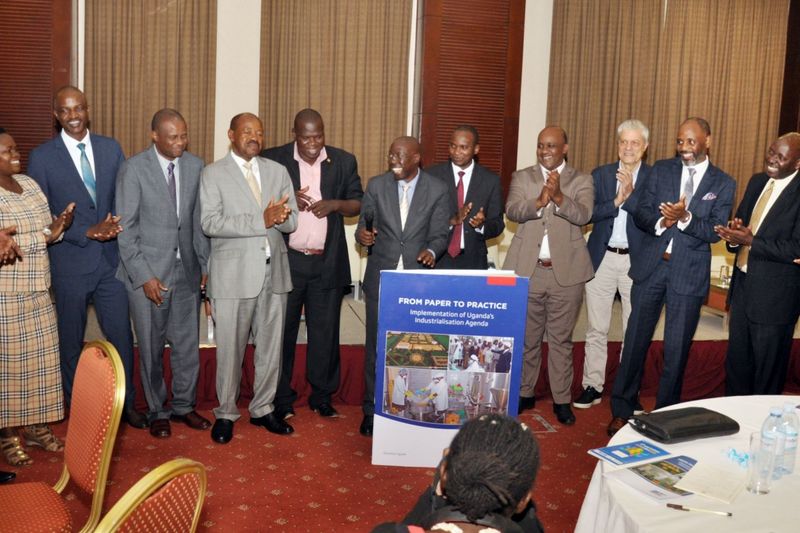
Mr. President, you made 2019 a year of commissioning new factories; but where is the plan?

Author Mr. Ramathan Ggoobi (left) with
Mr. Rolf Paasch, the Resident Representative Friedrich-Ebert-Stiftung (FES) Uganda
Any well-meaning or unbiased Ugandan would agree that 2019 has been a year of action. Perhaps the only year fitting the “kisanja hakuna mchezo” (no nonsense term) slogan crafted in 2016 to underscore the seriousness with which the current Government was going to deal with service delivery during the period 2016 – 2021.
Apart from the roads, dams and bridges that Government spokespeople love to highlight, President Museveni spent much of 2019 commissioning factories and/or breaking ground for the construction of new factories across the country.
In his State of the Nation Address delivered in June 2019, the President stated that “Government is prioritising investment in Industrial Parks to support industrialisation and create jobs.
“So far, there are 284 new factories in the Industrial Park at Namanve; 11 in Luzira Industrial and Business Park; 10 in Bweyogerere Industrial Estate; 8 in Jinja Industrial and Business Park; 10 in Soroti Industrial and Business Park; 16 in Kasese Industrial and Business Park; and 42 in Mbarara SME Park. The total (number of) factories in Uganda today are 4,900.”
He closed the year at Kapeeka in Nakaseke District, where 9 new factories at Liao Shen Industrial Park (popularly known as Kapeeka Industrial Park) were commissioned. This is good news for Ugandans, particularly the young people who badly need productive jobs.
Stop relying on agriculture!
I am one of those who strongly believe that most of the contemporary Uganda’s problems will be solved or lessened only when we change the structure of the economy. To change the structure of the economy means, in simple terms, that Ugandans should stop relying on agriculture as the main source of employment and income.
There is a large number of people who seem to believe that if we make improvements in agriculture we can raise the standard of the masses. This is the most fallacious argument that people make, often based on commonsense. This argument is advanced by those who either have never sat in an economics class or never took trouble to read economic history of nations.
The first and foremost fundamental fact of economics is that agriculture is always the least paying industry. Economic history teaches us that any country, whose population mainly depends upon agriculture, will always remain poor.
The second fundamental is that 20 acres is considered to be the smallest area which can keep a farmer in comfortable circumstances (not wealthy but financially comfortable). This is what empirical research shows. How many households in Uganda still own 20 acres of land or more? The last population and housing census (2014) put the average land holding in Uganda at 2.5 acres of land per family.
During the Christmas holiday, I was in my village in Butambala. The plots of land we grew up ploughing have shrunk to ridiculous levels, even for subsistence. The solution, therefore, should not and cannot be investing more in this subsistence agriculture. The solution lies in getting people, particularly the youth off land into other more productive sectors. This will relieve the land of population pressure and thus allow modern, technology-driven and high-yielding agriculture.
This is textbook economics that we have failed to apply. Uganda needs manufacturing industries that use locally produced inputs to facilitate structural change, create opportunities that are broad-based and universal.
Plans not as good as we think

Eminent persons that included MPs, Economists witnessed the launch of the report. Former Minister for Economic Monitoring, Kasirivu-Atwoki launched it.
For years, the Government has been singing how industrialisation is one of its top priorities. However, little action was being seen on the ground. I was, therefore, delighted to see some action during the past one year. The bad news, however, is that all this action; the factories being commissioned, the Industrial Parks being built, the investors (mainly Chinese and Indians) being attracted etc. are being done without a plan.
The popular view is that Uganda is good at making plans and policies but poor at implementing them. This view is held by so many people despite the lack of evidence about its veracity. First of all, what informed the verdict that Uganda’s plans/policies are good? Secondly, is Uganda’s implementation record as bad as many people believe? If so, what are the key factors behind this implementation challenge? What exactly needs to be done to turn Uganda’s industrialisation intentions into results?
These are the questions we asked ourselves and led us to conduct a research with the intention of answering them. The study culminated in a paper titled, “From paper to practice: Implementation of Uganda’s Industrialisation Agenda,” whose findings we released at the end of the year.
First, we found that contrary to the popular belief, Uganda’s plans/policies—when benchmarked with other countries that have been more successful—are not as good as people think. Most of Uganda’s plans do not have the required detail. They are developed without critical path analyses clearly showing (apart from the vision, mission, goals, and objectives) the targets, tasks and roles, responsible parties, budgets and resources, timeframes and schedules, outputs and outcomes, monitoring tools, and risks and contingencies of the intent.
We, for example, found that although at political level, the industrialisation intent is clear—i.e. building industries to add value to agricultural raw materials and minerals, and substitution of imports that are substitutable—there is implementation plan for this strategic direction. The devil in implementation is in the detail.
Decisions are not informed by evidence
What we have in Uganda are good pronouncements but not implementable plans. Following through the pronouncements to outputs and outcomes is Uganda’s biggest weakness.
Several government agencies are constructing factories that are not based on any technical or business thinking. Ugandan Investment Authority (UIA), Uganda Free Zones Authority (UFZA), Uganda Development Corporation (UDC), NAADS, Ministry of Agriculture (MAAIF), and Ministry of Science, Technology and Innovation (MoSTI) are all involved in building factories.
It is not clear what we want to do and how. We do not know whom we want to back and who we should not. If someone comes and says I want to make cars, we jump in, even where value addition is zero.
Secondly, decision making processes in Uganda are not informed by evidence, but individual opinions and politics. For example, we adopted the Industrial Park model, including defining where each park should be located, how many factories each should accommodate, and the enterprises that should be located in each of the parks, without any scientific study or feasibility study.
We are building industries without environmental impact assessments, life cycle cost analysis, land use planning, and risk management plans. Research shows that many countries that behaved like we are doing have built industrial parks that have not produced the expected benefits. Without a clear plan, we are likely to continue building factories without sustainable sources of raw materials, proper manpower, technology and markets. We might also end up building environmental disasters that we think are industries.
No one in charge!
Thirdly, we found no one actively in charge of Uganda’s industrial policy. The Ministry responsible for industry is the weakest MDA among the institutions that are supposed to implement the industrial policy. Its power to influence the sector is being diluted by duplicated mandates at Ministry of Finance, which was tasked with the development of industrial parks. The Ministry is one of the worst funded in government and thus badly lacking in technical capacity.
Uganda has a Minister of State for Investment (under Finance) and a Minister of State for Industry (under Trade); a Commissioner in Charge of Investment (at Finance) and Commissioner of Industry (at Trade). UIA, the agency responsible for developing the industrial parks, is domiciled in Finance. This has confused roles, policies (investment policy vs. industrial policy), and reporting, while the wider public is also confused about where to go for what service.
We recommended a separate Ministry for Industry and Investment (MII) should be created, since both these critical drivers of economic transformation are being made second fiddle in the priority lists of the sectors in which they fall. The Ministry of Trade, Industry and Cooperatives is more focused on trade issues (than industry), while Ministry of Finance, Planning and Economic Development is obviously more preoccupied with its primary mandate of raising funds to finance the budget.
We also found that the Office of the Prime Minister (OPM) and the Office of the President (OP) have failed to play the roles of chief coordinator and monitor of government agencies, and that of chief supervisor respectively. Both are preoccupied with implementation. The would-be monitors and coordinators of government business are busy chasing projects.
Although monitors at different levels compile reports on MDAs, there is no leadership to take action on the recommendations of the reports. The OPM simply compiles the reports into one big book called the Government Annual Performance Report (GAPR) which no one takes seriously. There are no sanctions for accounting officers who perform poorly, and no rewards for good performance. This is partly the reason everybody is running to the President.
What needs to be done?
Fourth, the budget is dictating what planning should do, instead of the other way around. The MDAs tasked with the delivery of industrialisation are facing serious budget gaps, while money is being wasted on consuming agencies. There is no prioritisation and thus the budget has become overwhelmed. Although quarterly releases by Finance have improved—by the 10th of the month at the beginning of each quarter—the spenders are not following plans and budgets while executing projects.
The issues affecting private sector are talked about but not planned for, not budgeted for. Investors are complaining about high cost of conversion in terms of electricity, logistics, tax administration system, standards formulations and administration, no competition law. These issues are affecting manufacturers’ competitiveness at the continental level. They need well-planned and well-serviced industrial parks and export processing zones.
In the next part of this report, we shall show where implementation power in Uganda lies and how this is failing execution of government’s well-intended projects. We shall also explore the factors that delay or fail implementation in Uganda as well as some of the successes of the industrialisation drive in Uganda that should be consolidated and scaled up.
We shall finally highlight the recommendations of the study to improve implementation performance, and, most importantly, to ensure that Uganda’s industrialisation intentions are turned into results.
These intentions, enshrined in the Vision 2040—uplift industry to contribute 31% of GDP, making industry employ 26% of Uganda’s labour force, and ensuring that 50% of Uganda’s exports become manufactured by 2040—are not only beautiful goals but attainable if the findings of this study and recommendations are implemented. Wishing you a Happy 2020, full of renewed, well-planned and well-executed industrialisation drive.














Ramathan Ggoobi
Ramathan Ggoobi is Policy Analyst, and Researcher. He lecturers economics at Makerere University Business School (MUBS) and has co-authored several studies on Uganda's economy. For the past ten years, he has published a weekly column 'Are You Listening Mr. President' in The Sunrise Newspaper, Uganda's Leading Weekly
Leave a Comment
Your email address will not be published.